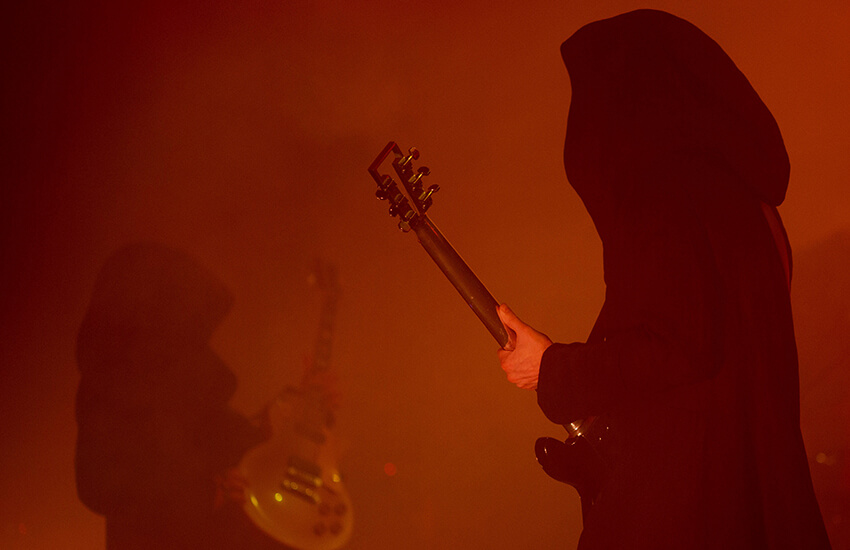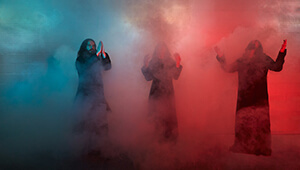Text by Stephen McLaughlin

It’s not something that frequent to have one’s ears bleed/blessed by the cavernous drone doom of metal titans Sunn O))) twice, only just a few days apart. One could get too easily used to it. Right after performing at Unsound Kraków in mid-October, ten years since their first and only appearance at the festival and with a fresh album under their cloaks, we caught the band again at the Roundhouse in London. Both performances were similar in structure and intensity, though the London one was experienced with a fresher mind and more fully.
Sunn O)))’s consistent core of Stephen O’Malley and Greg Anderson have been operating now for 2 decades with a rotating cast of operatives from the worlds of extreme metal, experimental and electronic music and have served to create an entirely new subgenre of bands that blur these boundaries. riding high off the back two fantastic albums this year. Life Metal and Pyroclasts, these are a welcome return to form after the slight disappointment of 2016s Kannon.
This year’s albums, aided by Steve Albini’s production prove that they are unsurpassed in terms of metallic minimalism. Sunn O))) live performances have always offered a different proposition though, the theatricality and sheer visceral weight of their guitars unlock a primal appreciation of what they do. Using various volcanic materials as analogies for their work has become a bit of an overused trope but given that they called their recent album Pyroclasts we are going to invoke it.
The interplay of explosively loud and lava slow guitar work overloaded with sub-bass and feedback delivered through solid-state amps has been the vocabulary they have used since their inception and have managed to scale that significantly given how devoid of the traditional signifiers of metal they are. Their audience has always reflected this mishmash of influences, with a demographic of battle-vested trad metalheads holding it all together. At their performances, the space itself becomes a player as anything in their way is resonated by the sheer weight of sound, metalwork and masonry spasms, adding a further dissonant layer.
The air is a thick soup of dry ice to the extent that, generally, the only evidence of a band is the occasionally raised fist and the tips of the crescent of amplifiers, the rest obscured in a vibrant gradient of red, yellow and blue smoke in various evolving ratios echoing Samantha Keely Smith’ paintings from their recent albums. There is a constant tension to just how long they can stretch each of these chords out and when the shock of a second chord will land (not to mention when they go wild and actually change that chord).
A slight disappointment among some of the crowd could be felt at the lack of on/off frontman Atila Csishar’s guttural mix of Sanskrit chants and throat singing that has acted as a focal point for live actions operating at a level above the churning bed of guitar. The current lineup features Hildur Guðnadóttir, herself at a career peak off the back of acclaimed soundtracks for Chornobyl and Joker, on organ who fills this higher-end with another layer of oscillating Leslie speaker effects interacting with the modulations of guitar feedback.
Shockingly for the first time in an hour, the bass intensity disappears, and the smoke clears leaving space for Steve Moore’s trombone to take the lead for a stretch that is both joyous and mournful and feels especially poignant after the previous sections’ monotone palette and a reminder of his work on Alice from Monoliths and Dimensions.
He retreats, and the intensity returns, bolstered much more by the organ in the final slide down the hill to the end. When the smoke clears, many of the crowd have given up, but those who’ve braved the endurance test are euphoric, especially so when the band returns to the stage to meditate on a single chord for another 15 minutes as a nod to the daily recording exercises that make up Pyroclasts. After 2 hours of this, one wouldn’t begrudge an audience for trickling out, but the majority stayed to soak up this final blissful drone.
For a band who began as an experiment in how dark they could drag their sound, their current incarnation has, in its own way, inverted this into an affirmation. Life Metal 4 LIFE.






